The MSI GE76 Raider Review: Tiger Lake Plus Ampere Equals Framerate
by Brett Howse on September 8, 2021 9:00 AM EST- Posted in
- Laptops
- Gaming
- Intel
- MSI
- NVIDIA
- Core
- Tiger Lake
- GeForce RTX
- Ampere
- Tiger Lake-H
- TGL-H
System Performance
For 2021, MSI has moved to Intel’s newest 11th generation Tiger Lake H-Series processors in the Raider lineup, which brings a lot of advantages over the 10th generation Comet Lake product. The new 10 nm processor features the newest Willow Cove cores which offer a lot of performance over the outgoing Skylake-based 14 nm generation. For the GE76 Raider, MSI offers up to the Core i9-11980HK processor which offers eight cores plus hyperthreading and a peak single-core boost frequency of 5.0 GHz. If you like to tweak your devices, MSI also offers overclocking on this model to get the maximum out of the device.
For a deeper dive into the new Tiger Lake-H platform, please refer to this Intel Reference Design system we tested back in May. When we tested it, the reference design arrived with basically no power limit set, which the reference design could not handle, so for the review, the TDP was set to 45-Watts as that is the “nominal” power level of the H-Series platform historically. TDP is important, as Intel does specify 35-Watt, 45-Watt, and 65-Watt levels for the 11th gen laptop platform, but the Core i9-11980HK offers both 45 and 65-Watt TDP ranges. If the platform can cool it, performance will be much better with a higher TDP since the system will not have to scale down the frequency as aggressively. Intel’s Reference Design laptop could not handle the 65-Watt base, but MSI's desktop replacement system here is designed to do that - later in the review we will go over the thermals in more detail, but perhaps without much surprise, MSI fares much, much better.
To see how the MSI GE76 Raider performs it was run through our standard laptop testing suite. If you would like to compare the results against any other system we have ever tested, please use our Online Bench tool. For those unaware, all tested laptops get sent back to the manufacturer post-review, so when we add new tests to the suite, older systems will not be included in the results since the test was not run.
For this review our comparisons will be other desktop replacement systems, including the AMD powered ASUS G513QY with Ryzen 9 5900HX, Intel’s Tiger Lake reference system, and a few older systems including the previous generation MSI GE75 Raider.
PCMark 10
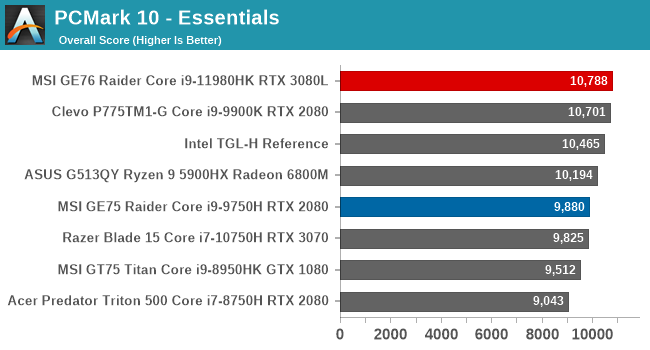
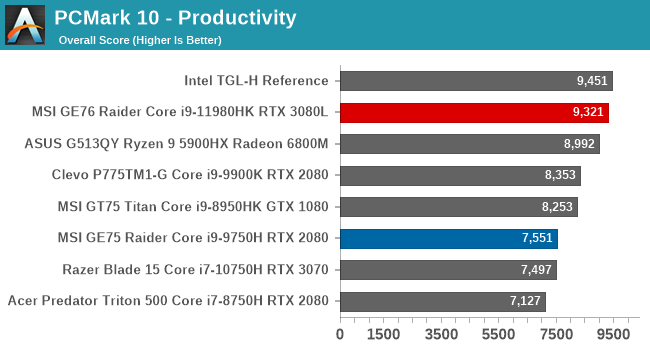

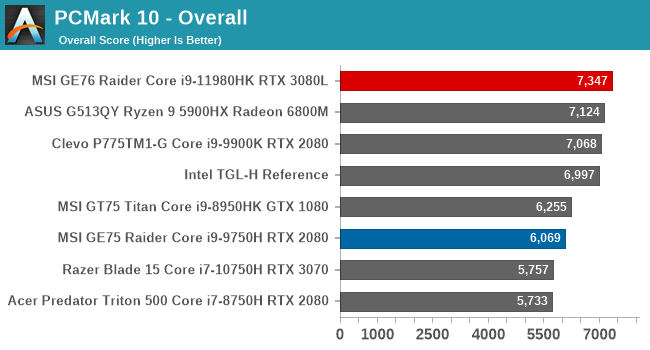
PCMark is a full-system benchmark which highlights CPU performance, but also includes the GPU, memory, and storage as factors in the outcome depending on the test being performed. With Intel’s fastest Tiger Lake processor coupled with the NVIDIA RTX 3080L, the MSI GE76 Raider is the fastest laptop we’ve tested in the overall PCMark 10 suite. Not a bad start.
Cinebench R20
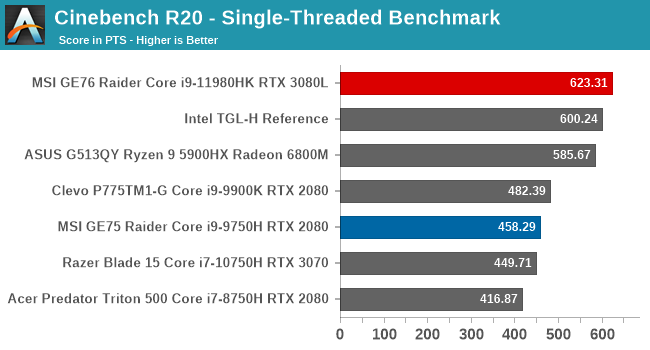
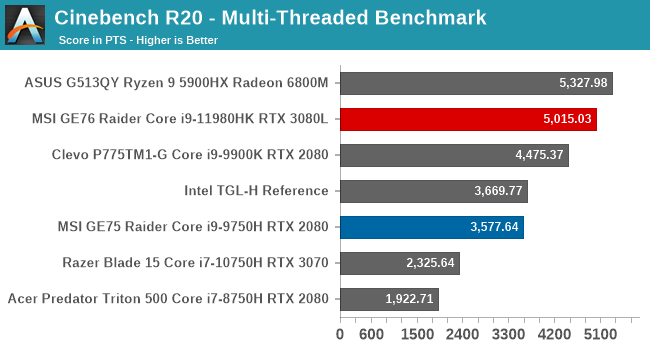
Intel’s Tiger Lake reference system proved that Intel once again holds the single-threaded performance crown, and with MSI running at the higher TDP range for the Core i9-11980HK, it pulls ahead even further. AMD still provides more multi-threaded performance thanks to more efficient cores.
Handbrake
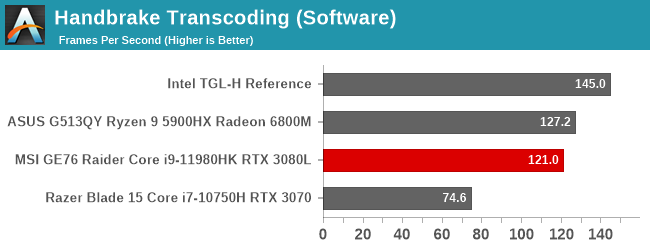

If you need to transcode content, Handbrake allows the choice to use the software encoder for the best quality, or one of the hardware-based encoders for a quicker conversion. The AMD powered ASUS system edges the MSI in software slightly, but the RTX 3080L with its massive 165-Watt TDP in the MSI allows it to edge the other systems.
7-Zip
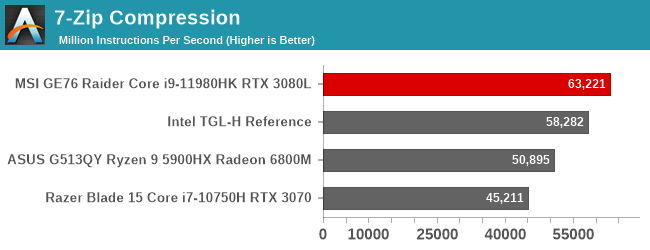
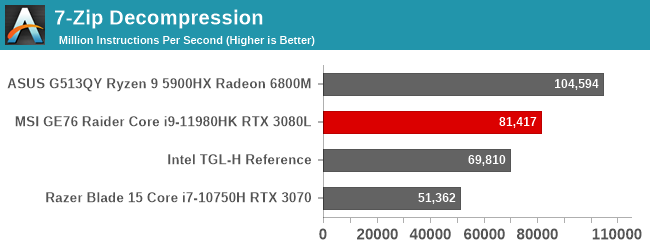
File compression and decompression is another common task, and it is very interesting how different the AMD and Intel platforms perform these tasks. AMD has a clear advantage in decompression, but Intel’s single-threaded performance advantage seems to give it the edge on the compression side. The MSI’s higher TDP for Tiger Lake provides it an advantage here.
Web Tests
Web performance is not just a CPU test, but also a browser test, since web performance is predicated on the underlying browser scripting engine. For all tests, we leverage Microsoft Edge, although any benchmark result is a point in time, since browsers are constantly updated which may impact the results.
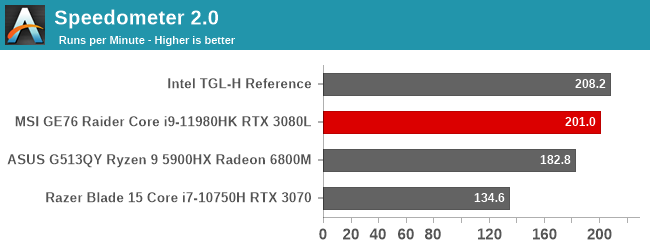

Intel’s Tiger Lake platform has upped the game for web performance again, and the MSI system is able to squeak past the Ryzen 9 5900HX in both WebXPRT and Speedometer. Single-threaded performance is still important, even with eight cores and sixteen threads available.
Storage Performance
To test storage performance, we use the recently added storage tests for PCMark 10, which leverage real-world storage traces and provide a much more realistic result than just looking at peak speeds. A big advantage of Tiger Lake over the outgoing Comet Lake platform, as well as AMD’s Cezanne, is that Intel has added PCIe 4.0 storage support for this generation. MSI has outfitted review unit GE76 Raider with the Samsung PCIe 4 PM9A1 1 TB drive, although since drives are a commodity now, there is no guarantee that will be installed in all systems sold at retail.

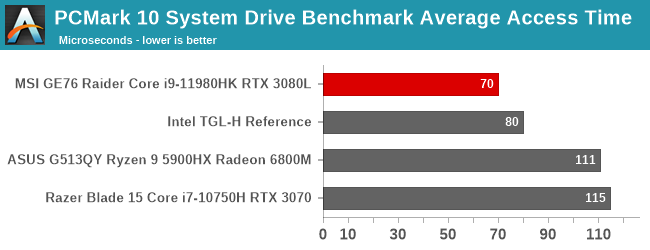
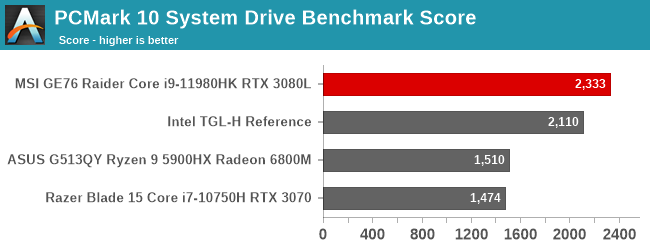
The Samsung PCIe 4 drive is easily the quickest drive we’ve tested yet, with a fantastic average access time of just 70 microseconds, and an overall score of over 2300. If storage performance is key for your workflow, the MSI GE76 Raider will handily fill the bill.











33 Comments
View All Comments
Vitor - Wednesday, September 8, 2021 - link
After 200hz, diminishing returns hit hard.Prestissimo - Wednesday, September 15, 2021 - link
Yes it is. What's dumb is MSI clearly topped the 360Hz on the most sh*tty panel they could find.Instead, what they should have done is use a "high-end" [600nit 16:10, QHD, 144Hz, 3ms, LTPO display with perfect colors] and then maybe build on that Spec to improve the refresh rate later on.
Then nobody here would be complaining at all.
Spunjji - Friday, September 10, 2021 - link
It really is particularly bizarre in a notebook. 1080p is a low resolution for a 17.3" display - at this price, the 4K 120Hz makes much more sense. You can always run at 1440p and use an upscaler if the performance isn't there to hit the display's full refresh rate, and Windows looks amazing at 200% scaling.sheh - Wednesday, September 8, 2021 - link
Almost good keyboard layout, but what's with the duplicated backslash key instead of Menu?(Does it produce a unique code that can be remapped?)
And not sure, but I think I'd prefer Fn to be at the left side.
sheh - Wednesday, September 8, 2021 - link
Plus, Power is in a somewhat unfortunate location. Can be pressed accidentally.And no Pause, but instead Scroll Lock?!
DanNeely - Wednesday, September 8, 2021 - link
But the "Excel is Broken" key is vital to any modern office experience. Nothing matches the fun of not being able to work because your arrow keys suddenly stop doing what you expect.DanNeely - Wednesday, September 8, 2021 - link
MSI's been doing that for a number of years. I don't overly fault them for using the same physical keyboard in the US/abroad; but the extra key in the lower right could be mapped to something considerably less stupid (ie a menu/right click key; or a second windows key) for the US model. Their not doing that is a long standing mystery.undervolted_dc - Wednesday, September 8, 2021 - link
those are notebook, battery usage to performance should be the metrics that count here..what I see here is +5% performance ( not in multithreading , mainly in storage and in gpu ( with a gpu that probably costs 1.5x the AMD's one ) ), and -30% battery life.. amd has won hands down
m00bee - Wednesday, September 8, 2021 - link
no one cares for battery life in gaming notebook. it's like having built-in UPSAlistair - Wednesday, September 8, 2021 - link
These laptops are nothing special. I can buy an open box RTX 3070 laptop from Bestbuy for $1299. The RTX 3080 is a pointless product, as it is just a 3070 in disguise, it doesn't use the RTX 3080 desktop chip.$1299 or $3399, you're not getting a lot more for your money.